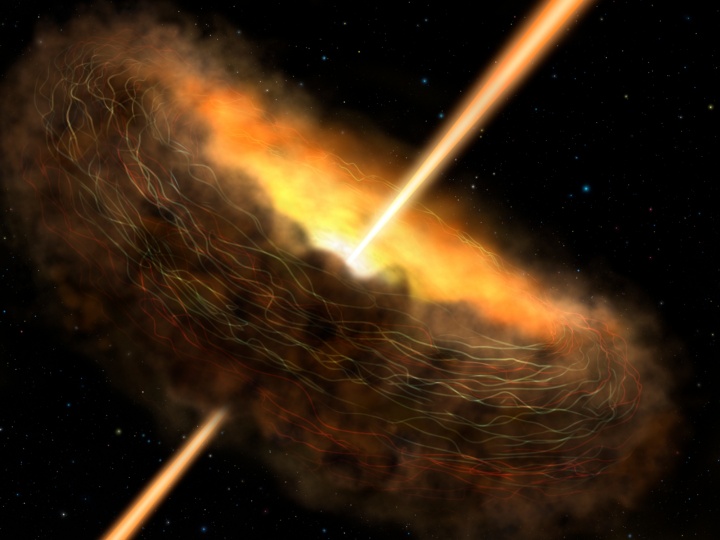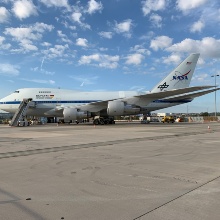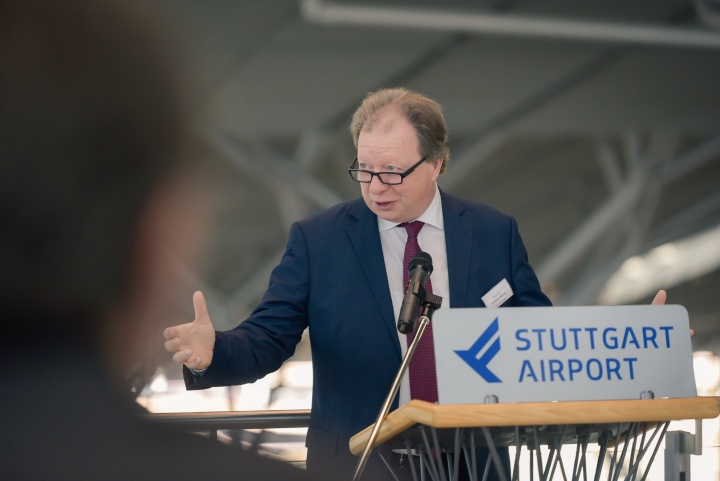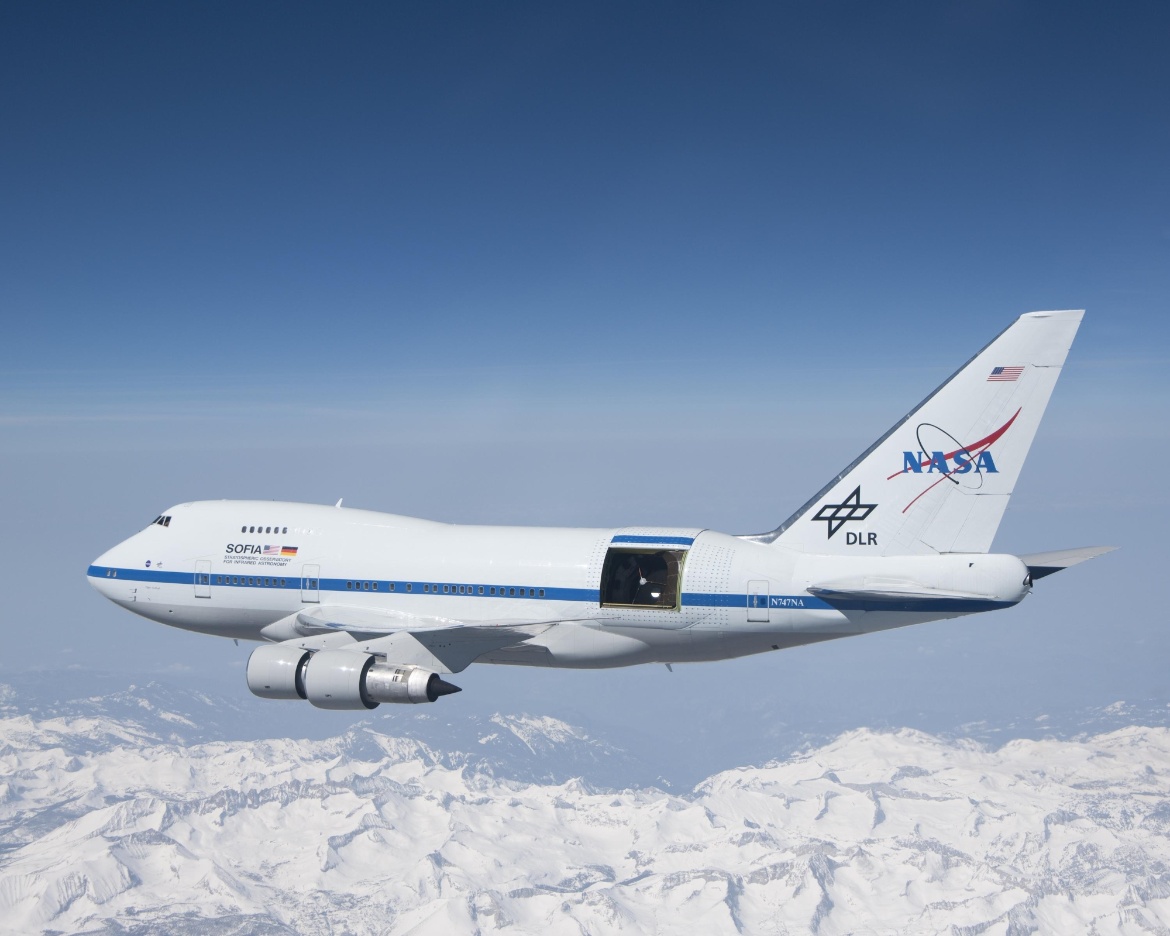The reason for SOFIA’s visit to Stuttgart was the “Mission to the Universe – From Earth to Planets, Stars & Galaxies” conference held by the German Astronomical Society, which organized the DSI at the University of Stuttgart. Roughly 250 researchers from around the world have met at the Vaihingen Campus at the University of Stuttgart from September 16-20. The German Astronomical Society is one of the oldest astronomical societies in Europe. It was founded in 1863.
Likewise, an exhibition with models, videos and informational material explains some of the special features of the observatory as well as the astronomical mission of the flying infrared observatory in a way which is suitable for the general public.
Time: September 16-27, 2019
Location: Stuttgart Airport, terrace level in Terminal 3, next to the exit to the visitor terrace
SOFIA was combining its trip to Stuttgart with what will be a first. On September 18, the flying observatory SOFIA tooked off from Stuttgart Airport shortly after sunset on its first scientific observation flight over Europe. During the mission, which is due to last about ten hours, the crew would carry out a number of astronomical observations. Scientists want to investigate the area around the supermassive black hole in the galaxy Markarian 231 in the constellation Ursa Major, to give just one example. They hope to gain new insights into the connection between the magnetic fields in the disc structure around the black hole and the radio jets – the highly focused and runaway gas accretions perpendicular to these discs, which among other things transmit intense radio emissions. This kind of observation is only possible with SOFIA, because no other observatory can measure magnetic fields in this wavelength range.
One advantage of flying over Europe is that SOFIA will be further north than its usual base in southern California. The nearer to the poles the infrared observatory flies, the less water vapor there is in the atmosphere around it – and the better the conditions are for making observations. The SOFIA team has obtained a special permit from the local authorities exempting it from the restrictions on night flights for the return at around 5.30 am on Thursday, which is shortly before Stuttgart Airport actually starts operations at 6 am.
SOFIA welcoming event: Welcome to STR without the “star guest”
A number of guests from the worlds of science, business and politics accepted the invitation from the University of Stuttgart and Stuttgart Airport and met on the terrace in Terminal 3 on the morning of Sunday, September 15, 2019 to welcome the airborne observatory SOFIA (Stratospheric Observatory for Infrared Astronomy) to Stuttgart Airport.
SOFIA causing a stir at the University of Stuttgart
The Rector of the University of Stuttgart, Prof. Wolfram Ressel, was visibly happy at SOFIA’s latest visit to Stuttgart, and highlighted the significance of the research project for the University of Stuttgart. “We are pleased that our commitment doesn’t just result in a lot of engineering and astronomical research projects being carried out, but also that we can give students the opportunity to complete their student projects actually at NASA in the USA.” He went on to say that it was important to keep showing society that taxpayers’ money invested in research – such as the significant amounts which have been invested in SOFIA – is money well spent.
Guided tours of SOFIA
In Stuttgart, those who are interested can see SOFIA for themselves from the airport’s visitor terrace, which is free of charge to enter. What’s more, they can also sign up for a guided tour of the observatory. There are a limited number of places available. Registration must be done online. Because the aircraft will be based on the apron of the airport, those wanting to go on the tour must go through the same security checks as when checking in for a flight. One person can register up to five people at once – providing he or she gives their full names and dates of birth.
Tours available on September 16, 17 and 19:
Length: roughly two hours
Online registration: possible in two stages from Thursday, September 5 at 7.00 am and 7.00 pm at: http://bit.ly/2MP9Upb
Planetarium show and exhibition
In a mobile planetarium in fulldome format, viewers can experience a SOFIA flight up close, including the preparations. Entrance is free.
Show times:
Monday, September 16: 10.00 am, 11.30 am, 4.00 pm and 6.00 pm;
Tuesday, September 17: 10.00 am, 11.30 am, 4.00 pm and 6.00 pm;
Wednesday, September 18: 10:00 am, 11.30 am;
Thursday, September 19: 11.30 am, 4.00 pm and 6.00 pm
Length: 45 to 60 minutes
Location: Stuttgart Airport, between Terminals 0 and 1
Likewise, an exhibition with models, videos and informational material explains some of the special features of the observatory as well as the astronomical mission of the flying infrared observatory in a way which is suitable for the general public. On September 16, 17 and 19, schoolchildren from the network of schools that make up the German SOFIA Institute (DSI) at the University of Stuttgart will explain the special features of SOFIA and its mission, which includes infra-red experiments among other things.
Time: September 16-27, 2019
Location: Stuttgart Airport, terrace level in Terminal 3, next to the exit to the visitor terrace
Annual Conference of the German Astronomical Society
Public lecture
An exciting part of the German Astronomical Society’s conference for the public is a lecture. Under the title of “A look into a hidden universe – highlights of the flying observatory SOFIA”, Dr. Harold Yorke, Director SOFIA Science Mission Operations reports on some of the important new scientific discoveries made by SOFIA and what they mean for our understanding of the cosmos. This is followed by a short presentation from the Japanese astrophysicist Dr. Yoko Okada from the University of Cologne about her experiences flying on board the plane. Flying on board the plane has enabled her to collect data for researching interstellar space in the Milky Way. The debate will be moderated by the German physicist and ESA astronaut Prof. Reinhold Ewald.
Time: September 19, 2019, 8 pm
Location: Hospitalhof, Büchsenstraße 33, 70174 Stuttgart
The Flying Observatory SOFIA
Background information on the observatory
The Stratospheric Observatory for Infrared Astronomy (SOFIA) observes faraway stars and galaxies and locates chemical compounds in space from a height of around 40,000 feet, undisturbed by the majority of the water vapor in the Earth’s atmosphere. What makes SOFIA unique is that it can see far infrared light. No other ground-based telescope or satellite telescope can currently carry out the tasks that SOFIA does.
The flying observatory SOFIA has an array of instruments which react to the different properties of infrared light. A large proportion of the light in the universe is emitted as infrared light, and doesn't reach the earth’s surface. The infrared observations carried out by SOFIA, which flies almost completely above the water vapor in the earth’s atmosphere, means that it is possible for example to investigate the areas where stars are formed, which stars and planetary systems then emerge from. These measurements and analyses are not possible using observations taken in visible light.
The high-resolution infrared camera HAWC+ has been in use on board the observatory for about a year. It is currently the only imaging camera which takes pictures in the far infrared region of the electromagnetic spectrum and so can measure cosmic magnetic fields. Astronomers can use this data to investigate the early, cool stages of how stars and planets are formed.

SOFIA, the Stratospheric Observatory for Infrared Astronomy, is a joint project between the German Aerospace Center (DLR) and the American National Aeronautics and Space Administration (NASA). It is realized on the initiative of the DLR, with funds from the German Federal Ministry of Economics and Energy (BMWi) based on a resolution of the German federal government and with funds from the state of Baden-Württemberg and the University of Stuttgart. Scientific operations are coordinated by the German SOFIA Institute at the University of Stuttgart on the German side and the Universities Space Research Association (USRA) on the American side. The development of the German instrument was financed by funds from the Max Planck Society (MPG), the German Research Foundation (DFG) and the DLR.




